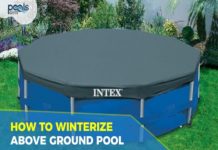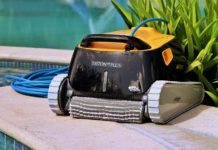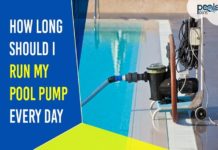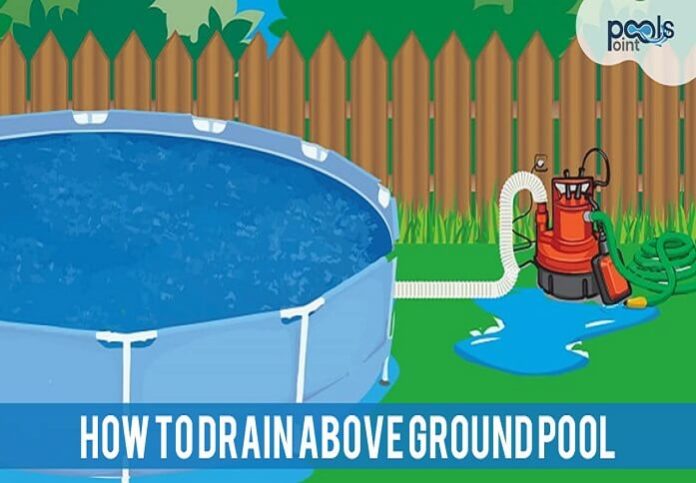Do you need to remove some or all of the H2O in your above ground swimming pool? This process is needed for various reasons.
They include contaminated water, bad winterizing, liner replacement, and setting up a new above ground pool. In all these cases you’ll need to know how to drain above ground pool.
The main options you have are a pump and hose. It’s also important to take the right steps to make the process smoother and help to avoid possible issues when draining the pool.
We’re here to help provide information about why, when, and how you should remove water from your pool.
Table of Contents
Why Drain Above Ground Pools?
Reasons to Drain Pools
Before getting to the nitty-gritty of how to drain above ground pool it’s important to know the various reasons why you’d need to drain your pool.
The process of filling a pool can take a full 24 hours depending on the volume of your above ground pool so it’s not something you’ll want to do too often.
Here are the main reasons you’ll need to drain your pool:
1. Improper winterizing
If you live in cold climates where winter temperatures drop below freezing you should definitely winterize your pool. It will take a while to do a thorough job but it will make the process of opening your pool in the spring much easier.
This process should involve various steps like:
- Testing water
- Adding winterizing chemicals
- Skimming water surface
- Cleaning walls/floor
- Winterizing pump/filter
- Installing pool pillow/cover
If you haven’t completed all these steps it can cause problems in terms of the water’s purity and chemical balance.
Whatever the reason not taking all the steps will likely require you to drain the pool when springtime rolls around.
2. Contaminated water
If you find a tiny bug in your above ground pool should you drain it? It’s probably not necessary. However, what if debris forms a layer on your pool’s surface, algae is caked on the walls and floor, and the water’s pH/alkaline levels are off the charts? That’s a different story.
It’s really a judgement call. That said, if the water is so contaminated it’s creating a health hazard you should definitely consider draining the pool water.
This highlights the need to maintain your pool effectively. If you do that you can help reduce how often you’ll need to drain the whole pool.
3. Change liner
As with other components of above ground pools the liner will have to be changed from time to time. You can reduce how often you’ll need to replace the above ground pool liner by selecting a quality one. This will add to your total investment but can save you money in the long term.
It’s also important to maintain the liner effectively. That includes cleaning it with a brush from time to time as needed. Maintaining the pool’s water is also important to make sure the acidity doesn’t wear down the liner faster, for example.
How long do above ground pool liners last? The average lifespan is 6-10 years but several factors are involved including the unit’s quality and how well you maintain it.
The bottom line is you might have to replace your pool liner and if so the process involves draining the water.
4. Algae on surface
This is related to contaminated water but is a more specific situation. Algae forms on the water’s surface for various reasons. Maintaining your pool properly will help to prevent this situation but unfortunately some causes are beyond your control.
Here’s a simple test to do. If you’re unable to see the bottom of the pool then it’s time to drain the swimming pool.
Here’s why. Not only does this cause a health issue but it can also damage your pool pump, which is definitely something you’ll want to avoid due to the relatively high costs of items like sand filter pumps.
5. New pool
The average lifespan of an above-ground pool is 10-15 years. Like the pool liner various factors affect this figure. They include the pool’s quality, how often it’s used, and how well it’s maintained.
Sometimes you just might want to upgrade to a bigger or better above ground pool.
It doesn’t really matter why you bought a new pool. It’s unlikely you’ll want to maintain two units, which means you’ll need to close the old pool.
This process includes several steps including draining the water. As with the other reasons for draining your swimming pool it’s critical to know how to drain above ground pool.
6. High temperatures
If you live in an area with hot temperatures then the rate of water evaporation will speed up. This is especially true in areas like Phoenix, Arizona with an average daily temperature of about 75°F.
Even if you don’t live in such hot-weather climates you might experience faster rates of water evaporation during summer months.
If the temperatures are 100+°F you’ll need to refill your swimming pool on a daily basis.
Methods to Drain Above Ground Pools
When learning how to drain above ground pool it’s important to know the two main methods used to complete the task:
1. Electric Pump
This method not only drains your pool’s water but also lowers how much sweeping you’ll need to do. The pumps will boost your electric bill but it won’t cause it to spike.
After draining the pool make sure it’s not exposed to directly sunlight, which could cause the liner to shrink. This will also help to prevent the pool from being exposed to high winds and inclement weather.
2. Garden Hose
Here are the steps:
- Affix the hose to the faucet
- Turn on the water
- Let the water run into the pool
- Remove the faucet-end of the hose (Make sure the end is lower than the above ground pool)
- Wait while the water flows back
- Use hose to remove debris (The water level should be around 10 inches. Make sure the hose must remain at a lower level than your pool so the water flows out of the hose.)
- Sweep away water (This method leaves 4-5 inches of water remaining in the pool.)
- Dry pool before storing it (if necessary)
Here’s the other primary method for draining your pool. It’s advisable to drain the water on a sunny day to speed up the process.
One main drawback of this process is the draining will take a lot more time. You should expect the drain rate to be about 5 inches/hour. Pick a large hose to speed up the process.
Big Mistakes to Avoid
If you own an above ground pool it’s important to maintain it properly.
This not only can keep the unit in good working order but sometimes reduce how often you’ll have to implement how to drain above ground pool.
Here are some of the no-nos’s for owners of on ground pools:
1. Don’t leave the pool empty
There are exceptions to every rule. If you’re not planning to use the pool again then you probably won’t want to fill it up again.
On the other hand, if that’s not the case then you should definitely not leave the pool empty. In fact, experts explain this could cause a world of trouble.
In the case of above ground pools the liner can shrink. This could result in the pool liner tearing when you refill it. This is especially true with older liners since they’ll stretch less when refilled.
2. Don’t drain in cold weather
This is another issue related to the liner. The liner becomes less stretchy if you take this step, which could cause the same problems when refilling the pool.
3. Drain most water before adjusting liner
If you have to shift the liner make sure there’s only about 1 inch of water in the pool. If you leave too much water in the pool it will be tougher to do this task due to the extra weight on the liner.
Prep Step: Collect Supplies Needed
Like vacuuming or winterizing your pool it’s important to collect all the supplies you need before you start draining the pool.
This will make the process smoother and prevent the need to stop mid-stream (pun intended) and secure equipment/tools needed for the process.
The key is to have the main items required for draining your above-ground pool. They include the following ones:
Vacuum Pump
This assiduous tool makes it easier to drain your pool’s water and especially if you already have a vacuum pump.
Like when picking other equipment for your above ground pool it’s important to pick a unit that’s right for your wants and needs. Here are some of the main issues to take up so you’ll choose wisely:
Debris Clearance
When draining a pool the vacuum will be picking up some debris like leaves and twigs. Make sure to select a unit that’s effective in collecting big debris without getting clogged.
In fact, this is one of the main issues to take up in terms of the unit’s functionality.
This is a critical feature not only when you’re draining your pool but also vacuuming it. In that situation the main goal will be to remove debris so it’s just as important to pick a pool vacuum that won’t break down because it’s picking up large debris like leaves.
Applications
The most obvious purpose will be implementing how to drain above ground pool. However, you might want to use the vacuum for other functions like your spa, fountain, etc.
If that’s the case then you should pick a more versatile unit. The cost will be higher but it might be worthwhile since it’s still an investment in your home and possessions.
Total Investment
This issue isn’t technically related to draining your pool but is certainly a key issue. For example, besides purchasing the item there’s other future costs like care/maintenance, parts/labor, etc.
The old saying “You get what you pay for” usually applies. So if you want long-term use from the vacuum it’s better to invest in a high-quality unit.
The initial cost will be higher but you’ll save money in the long term due to fewer maintenance/repair costs.
Pumping Capacity
When draining your above ground pool this is certainly one of the main issues to consider. If you don’t mind spending more time for the process then a less-powerful unit won’t be an issue.
Meanwhile, if you want more juice to get the job done faster then look for units with a higher pumping capacity.
One issue to keep in mind is the pumping speed drops from the nominal/official speed as the depth of vacuuming increases. This is another issue to consider in terms of how long it will take to drain the pool.
Automatic/Manual
These are the main types of pool pumps. They both have pros and cons worth considering. An automatic/robotic vacuum is much easier to operate because the unit does all the work.
However, as you might expect the price tag is higher so you should be ready to pay a higher price tag.
Then there’s a manual pool vacuum. These units are cheaper but you’ll have to do less moving around to operate the unit.
So before picking a vacuum make sure to weigh whether price or convenience is a bigger priority for you.
Garden Hose
When learning how to drain above ground pool this is another major piece of equipment you’ll need. As with a pool vacuum there are many issues to take up and here are some of the main ones:
Overall Quality
It would be a mistake to think that all garden hoses are alike in terms of quality. Does this mean you can find a hose that will never get damaged?
No, but if you buy a cheap hose you’ll re more likely to deal with issues like kinks, leaks, and breaks. In some cases you can do some patch work and keep using the hose. However, in other cases the damage is so serious you’ll have to toss the hose.
What should you look for? Make sure to focus on issues like the material, craftsmanship, and brand. As a general rule if you spend more for a good hose you’ll have fewer issues with a particular garden hose.
Material
Garden hoses are generally made using vinyl or rubber. Vinyl garden hoses are available in several options. It’s important to consider the “ply” of such hoses. Hoses with a higher count are thicker and thus sturdier.
For example, a 4-ply hose is cheap but will also likely require more repairs. When a hose is more durable it will cause fewer problems like kinks/leaks when using the unit.
However, rubber is generally a better option for outdoor hoses used for functions like draining an above ground pool.
These units are durable, flexible, and function in wide temperature ranges. These are all benefits that can improve your swimming pool’s maintenance.
Couplings/Fittings
Look for hoses with aluminum/brass couplings since they’re sturdier than plastic. There should also be a washer between the hose/connector in order to reduce leaking.
On the other hand, if you have low hand strength then you should consider plastic connectors. This will make it easier to tighten/loosen the faucet when draining your pool’s water.
Length/Weight
These are both important factors to weigh when picking a garden hose for draining H2O from above-ground pools. When picking a garden hose make sure to pick a length you need instead of one you can afford.
This is especially true when you’re using the hose for a specific application like draining water from an on-ground pool. You’ll need the hose to be long enough to drain water at a ground level lower than your pool. This might be very close or a bit far from your pool.
It’s always better to have some wiggle room so you can conveniently drain water away from the pool. Another issue is you’ll need to drain the pool multiple times so picking a hose with the right length is exponentially important.
One issue in terms of the hose’s length is an expandable hose. If you ever need more length when draining your swimming pool you’ll have that option.
In terms of weight the main options are the durability of a heavy hose vs. the convenience of a light hose. A lightweight hose will be easier to move around when draining your pool but will also be less sturdy.
Since you’ll be dragging the hose around you should consider a Y-shaped adapter. This allows you to connect two hoses. If you consider this you should also consider the weight of the garden hose’s nozzle
How to Drain Pool Using Siphoning
1. Pick a sunny day
It’s advisable to drain your above-ground pool on a sunny day. This process will take longer than when using a pump so make sure you already give yourself enough time to complete the process.
2. Secure a garden hose
When learning how to drain above ground pool using this method it’s important you pick a hose that’s long enough.
It must stretch from your above-ground pool to the area where you want to dispose of the water. A related issue is you should pick an area that’s at a ground level lower than your pool.
The garden hose will drain around 6 inches of H2O/hour. Remember that smaller pools drain faster and larger hoses drain pools faster.
3. Use the drain plug with caution
It might seem more practical to just use your pool’s drain plug. That’s what it’s there for, right?
The problem with this option is the surface below the pool might get washed away, which could cause the pool to cave in and result in damage to the frame. Those are bad things!
4. Insert hose into the pool to siphon water
5. Attach hose to faucet
This will help to get the water flowing. Turn on the tap then let water flow into the pool. Then remove the faucet-end of the hose while keeping it below the swimming pool.
Water will then start flowing from your above-ground pool. Make sure to transfer the faucet-end hose quickly since the water will start flowing quickly.
6. Use broom to remove extra water left in the pool
7. Allow pool to dry
If it’s a sunny day it won’t take long for your pool to dry completely. If it’s a cloudy day simply use tons of big towels to get the pool dry. If you want a less manual option then use a vacuum hose.
How to Drain Pool Using Electric Pump
1. Attach pump to hose
This is the first step for how to drain above ground pool. Connect the pump to a garden hose
2. Drop the hose into the water
3. Start pumping out water
Continue this process until the water is around 10 inches. You can use another hose in order to vacuum out any dirt/debris in the on-ground pool. Make sure to also keep the hose lower than the pool so the water flows smoothly.
4. Sweep out any water
There might be some water remaining after you drain the water so you’ll need to sweep it away.
5. Dry your swimming pool
The main options are a big towel or wet/dry shop vacuum if you want a less labor-intensive option.
CONCLUSION
We’ve just reviewed when, why, and how to drain your above-ground pool. Whether you use the siphoning or pump method the process can prepare for fresh water, replacement liner, or new swimming pool.
The key is to take the right steps for how to drain above ground pool. This in turn will make the process as effective and efficient as possible. It’s water down the drain!









